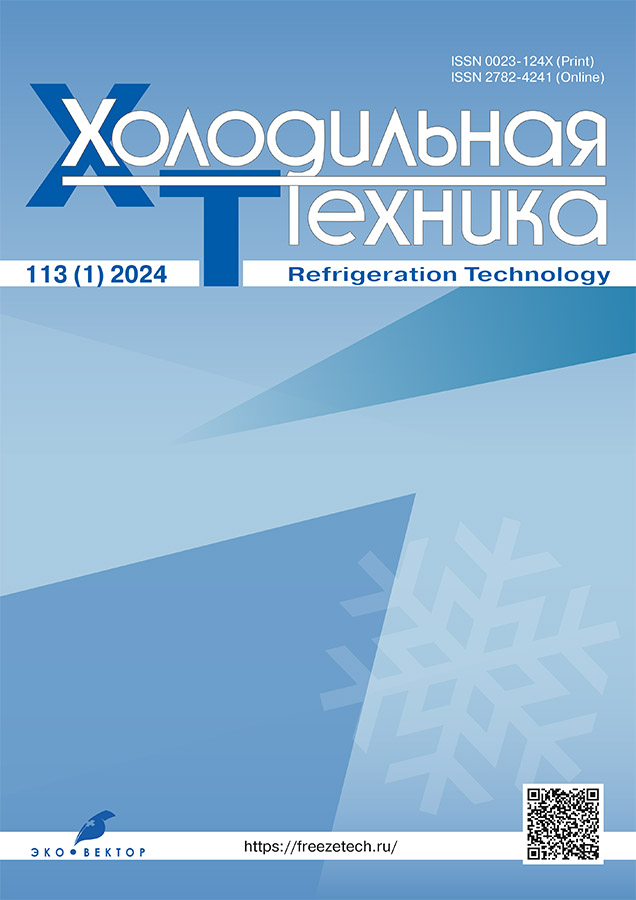Investigation on heat recovery strategies from low temperature food processing plants: Energy analysis and system comparison
- Authors: Ahrens M.1, Selvnes H.1, Henke L.1, Bantle M.2, Hafner A.1
-
Affiliations:
- Norwegian University of Science and Technology NTNU
- SINTEF Energy Research
- Issue: Vol 113, No 1 (2024)
- Pages: 41-53
- Section: Original Study Articles
- URL: https://freezetech.ru/0023-124X/article/view/636197
- DOI: https://doi.org/10.17816/RF636197
- ID: 636197
Cite item
Abstract
Industrial food processing plants often have significant thermal requirements at both low and high temperatures. These plants can produce a variety of products including frozen, chilled and grilled/steamed foodstuff, creating thermal demands at several temperature levels. Rapid freezing of the foodstuff at temperatures below -40 °C is required to preserve a high-quality product while steaming/grilling of foodstuff require heat above 100 °C. Heat recovery from the low-temperature refrigeration system provides an interesting opportunity to reduce the overall energy consumption of the plant. This paper presents different strategies to achieve heat recovery from a CO2/NH3 cascade refrigeration system. The low stage of the cascade features pumpcirculated CO2 circuits at -40 °C and -5 °C evaporation levels, while the high temperature stage consists of an ammonia circuit. For this investigation, a case is defined based on requirements for temperature level and heat quantity from the industry. Subsequently, different strategies for the integration and control of the energy systems are examined. Finally, the strategies are compared with selected key parameters and the results are presented.
This article is a translation of the article by Ahrens MU, Selvnes H, Henke L, Bantle M, Hafner A. Investigation on heat recovery strategies from low temperature food processing plants: Energy analysis and system comparison. In: Proceedings of the 9th IIR Conference on the Ammonia and CO2 Refrigeration Technologies. Ohrid: IIF/IIR, 2021. DOI: 10.18462/iir.nh3-co2.2021.0034 Published with the permission of the copyright holder.
Full Text
About the authors
Marcel U. Ahrens
Norwegian University of Science and Technology NTNU
Author for correspondence.
Email: marcel.u.ahrens@ntnu.no
Department of Energy and Process Engineering
Norway, TrondheimHåkon Selvnes
Norwegian University of Science and Technology NTNU
Email: marcel.u.ahrens@ntnu.no
Department of Energy and Process Engineering
Norway, TrondheimLeon Henke
Norwegian University of Science and Technology NTNU
Email: marcel.u.ahrens@ntnu.no
Department of Energy and Process Engineering
Norway, TrondheimMichael Bantle
SINTEF Energy Research
Email: michael.bantle@sintef.no
Norway, Trondheim
Armin Hafner
Norwegian University of Science and Technology NTNU
Email: marcel.u.ahrens@ntnu.no
Department of Energy and Process Engineering
Norway, TrondheimReferences
- Energy Efficiency 2O18: Analysis and outlooks to 2040. International Energy Agency; 2018.
- Papapetrou M, Kosmadakis G, Cipollina A, et al. Industrial waste heat: Estimation of the technically available resource in the EU per industrial sector, temperature level and country. Appl. Therm. Eng. 2018;138:207–216. doi: 0.1016/j.applthermaleng.2018.04.043
- Wallerand AS, Kermani M, Kantor I, Maréchal F. Optimal heat pump integration in industrial processes. Appl. Energy. 2018;219:68–92. doi: 10.1016/j.apenergy.2018.02.114
- Stampfli JA, Atkins MJ, Olsen DG, et al. Practical heat pump and storage integration into non-continuous processes: A hybrid approach utilizing insight based and nonlinear programming techniques. Energy. 2019;182:236–253. doi: 10.1016/j.energy.2019.05.218
- Schlosser F, Arpagaus C, Walmsley TG. Heat pump integration by pinch analysis for industrial applications: A review. Chem. Eng. Trans. 2019. doi: 10.3303/CET1976002
- Mateu-Royo C, Arpagaus C, Mota-Babiloni A, et al. Advanced high temperature heat pump configurations using low GWP refrigerants for industrial waste heat recovery: A comprehensive study. Energy Convers. Manag. 2021;229. doi: 10.1016/j.enconman.2020.113752
- Bergamini R, Jensen JK, Elmegaard B. Thermodynamic competitiveness of high temperature vapor compression heat pumps for boiler substitution. Energy. 2019;182:110–121. doi: 10.1016/j.energy.2019.05.187
- Kvalsvik KH, Bantle M. Generating hot water for food processing plant using waste heat, high temperature heat pump and storage. In: Proceedings of the 13th IIR-Gustav Lorentzen Conference on Natural Refrigerants. International Institute of Refrigeration; 2018:92–99. doi: 10.18462/iir.gl.2018.1111
- Stene J. Design and Application of Ammonia Heat Pump Systems for Heating and Cooling of Non-Residential Buildings. In: 8th IIR Gustav Lorentzen Conference on Natural Working Fluids. Copenhagen; 2008.
- Messineo A. R744-R717 Cascade refrigeration system: Performance evaluation compared with a HFC two-stage system. Energy Procedia. 2012;56–65. doi: 10.1016/j.egypro.2011.12.896
- Dopazo JA, Fernández-Seara J. Experimental evaluation of a cascade refrigeration system prototype with CO2 and NH3 for freezing process applications. Int. J. Refrig. 2011;34:257–267. doi: 10.1016/j.ijrefrig.2010.07.010
- Getu HM, Bansal PK, Thermodynamic analysis of an R744-R717 cascade refrigeration system. Int. J. Refrig. 2008;31:45–54. doi: 10.1016/j.ijrefrig.2007.06.014
- Ahrens MU, Foslie SS, Moen OM, et al. Integrated high temperature heat pumps and thermal storage tanks for combined heating and cooling in the industry. Appl. Therm. Eng. 2021;189(10). doi: 10.1016/j.applthermaleng.2021.116731
- Clauß J, Stinner S, Solli C, et al. Evaluation Method for the Hourly Average CO 2eq. Intensity of the Electricity Mix and Its Application to the Demand Response of Residential Heating. Energies. 2019;12. doi: 10.3390/en12071345
- Scoccia R, Toppi T, Aprile M, Motta M. Absorption and compression heat pump systems for space heating and DHW in European buildings: Energy, environmental and economic analysis. J. Build. Eng. 2018;16:94–105. doi: 10.1016/j.jobe.2017.12.006
- Overview of electricity production and use in Europe [internet]. European Environment Agency, 2018. Accessed 11.05.2020. Available from: https://www.eea.europa.eu/data-and-maps/indicators/overview-of-the-electricityproduction- 2/assessment-4
Supplementary files














